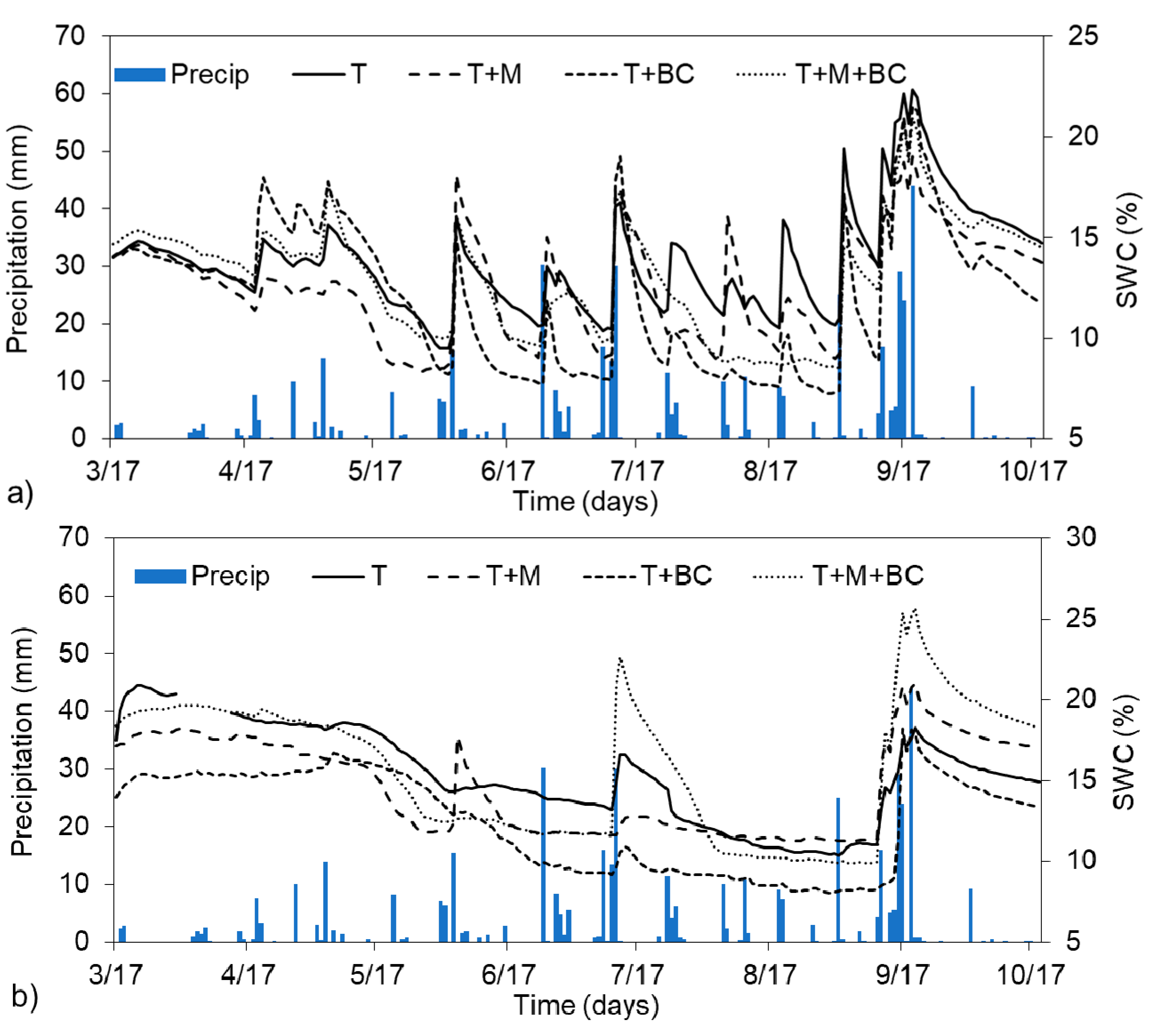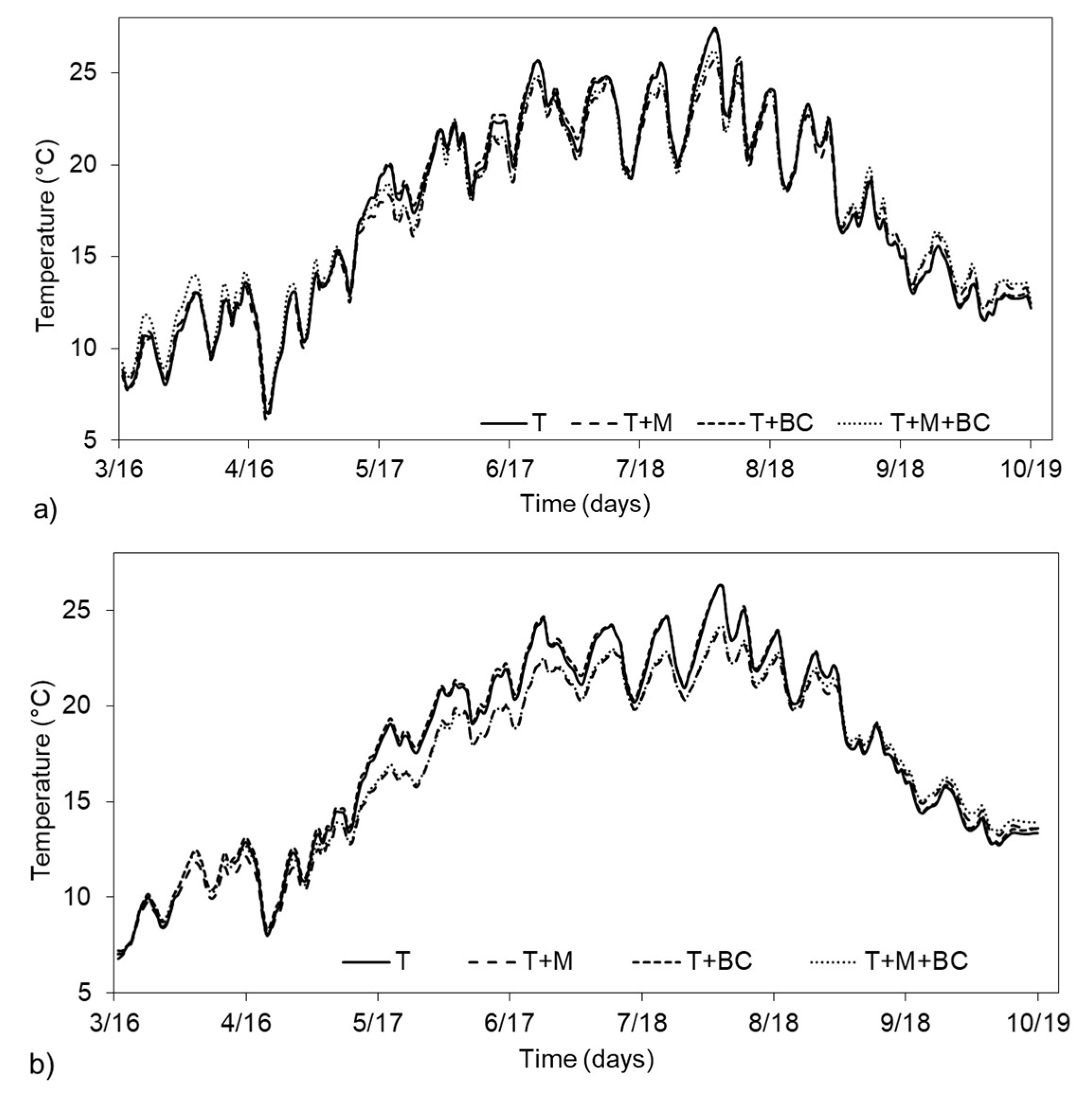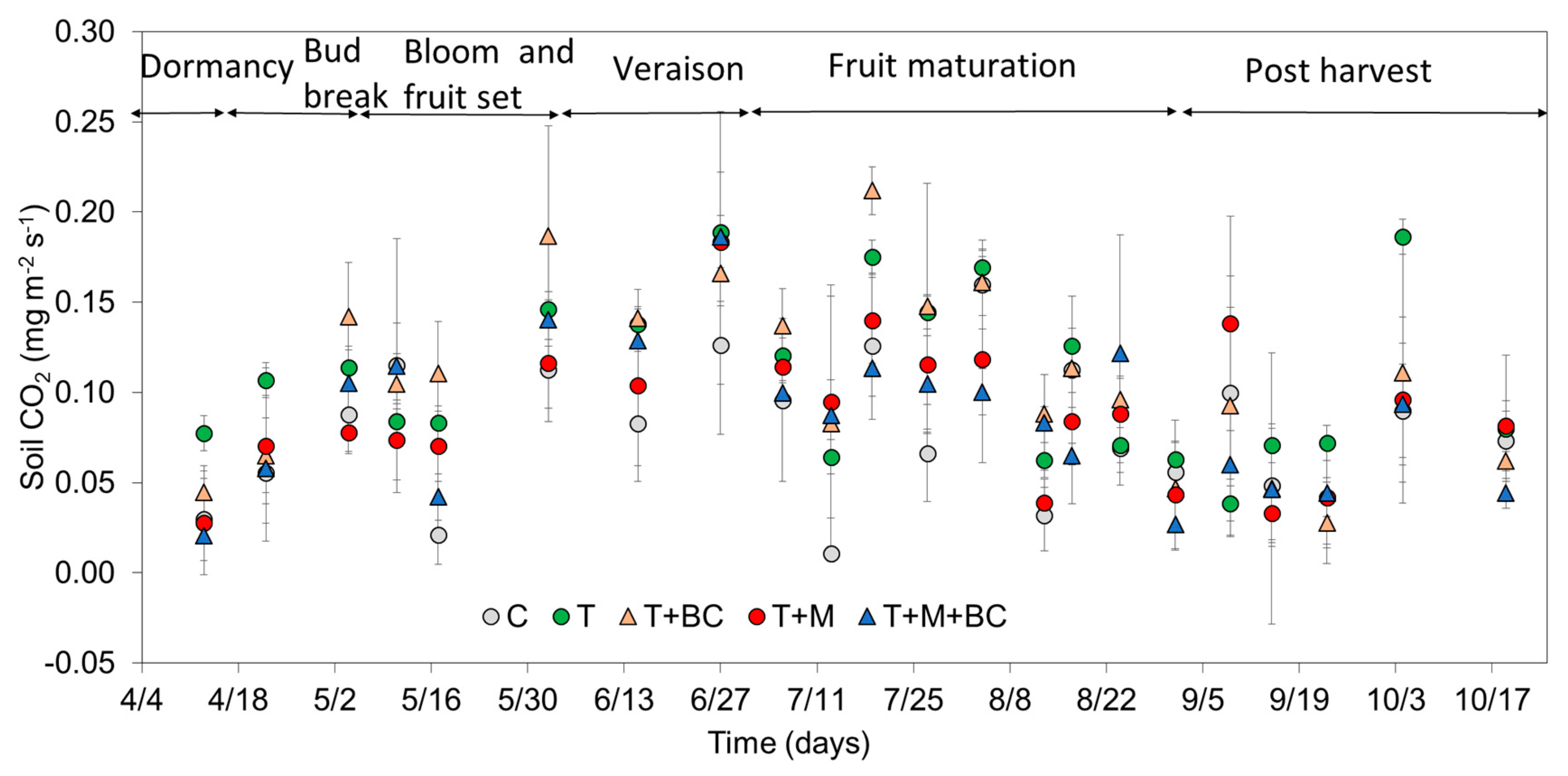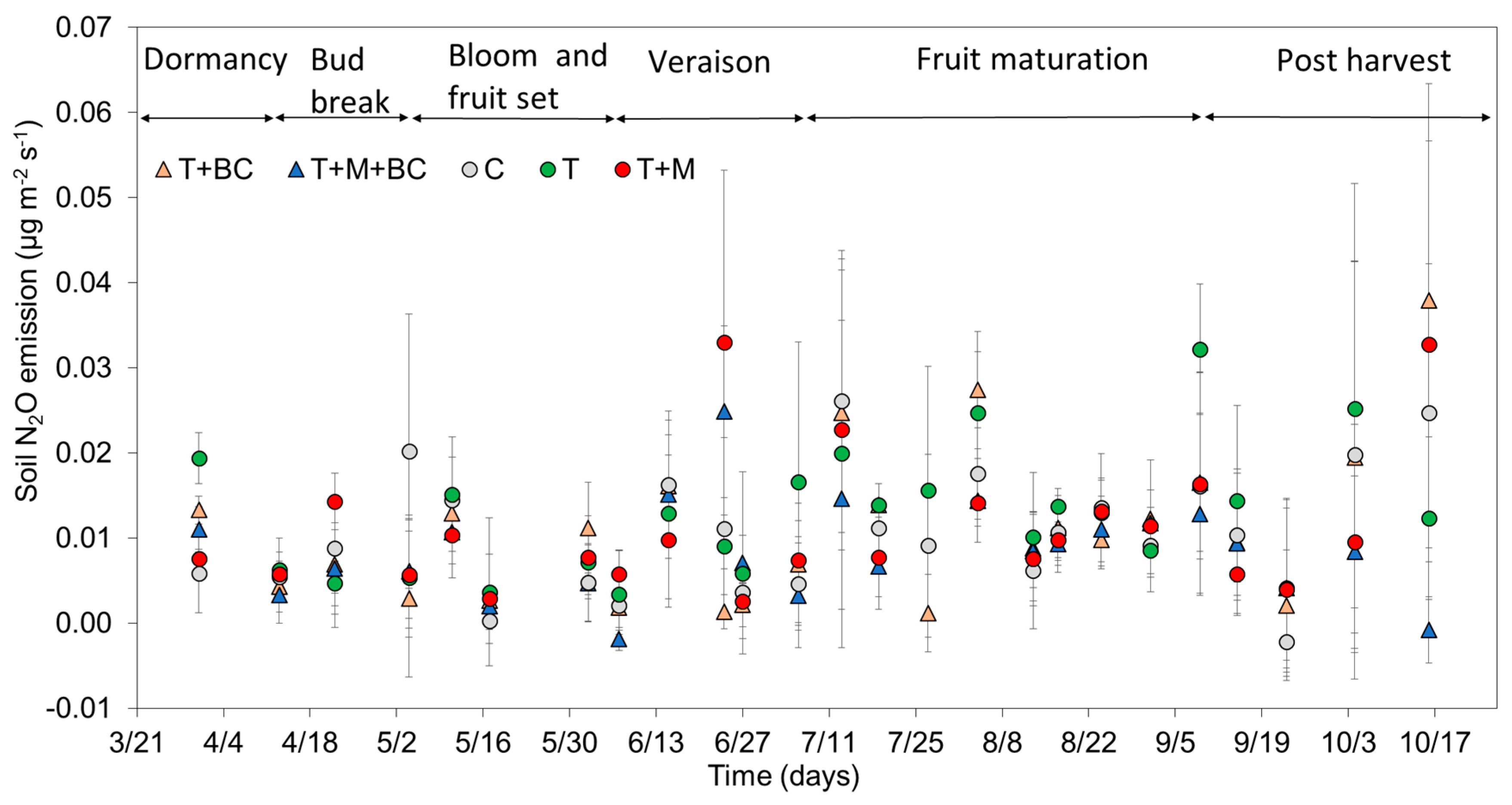Soil CO2 and N2O Emission Drivers in a Vineyard (Vitis vinifera) under Different Soil Management Systems and Amendments
Abstract
1. Introduction
2. Materials and Methods
2.1. Site Information, Experimental Setup, and Plant Growth Stages
2.2. Biochar Used in the Experiment
2.3. Physical and Chemical Characteristics of the Soil
2.4. CO2 Measurements and Gas Chromatography—Flame Ionization Detector (GC-FID) Analyses
2.5. N2O Measurements and GC-ECD Analyses
2.6. Statistical Analyses
3. Results
3.1. Soil Water and Temperature Changes over Time
3.2. Soil Respiration (CO2) Changes over Time
3.3. Soil N2O Emission Changes over Time
3.4. Effects of Soil Water and Temperature on CO2 and N2O Emissions
4. Discussion
5. Conclusions
Author Contributions
Funding
Acknowledgments
Conflicts of Interest
References
- Raich, J.W.; Schlesinger, W.H. The global carbon dioxide flux in soil respiration and its relationship to vegetation and climate. Tellus B 1992, 44, 81–99. [Google Scholar] [CrossRef]
- Schlesinger, W.H.; Andrews, J.A. Soil respiration and the global carbon cycle. Biogeochemistry 2000, 48, 7–20. [Google Scholar] [CrossRef]
- IPCC. Mitigation of Climate Change. Contribution of Working Group III to the Fifth Assessment Report of the Intergovernmental Panel on Climate Change; Cambridge University Press: Cambridge, UK, 2014. [Google Scholar]
- Smith, A.K. Introduction. In Nitrous Oxide and Climate Change; Smith, K., Ed.; Earthscan LLC.: Washington, DC, USA, 2010; pp. 1–3. [Google Scholar]
- Smith, P.; Martino, D.; Cai, Z.; Gwary, D.; Janzen, H.; Kumar, P.; McCarl, B.; Ogle, S.; O’Mara, F.; Rice, C.; et al. Greenhouse gas mitigation in agriculture. Philos. Trans. R. Soc. B Biol. Sci. 2008, 363, 789–813. [Google Scholar] [CrossRef] [PubMed]
- Huang, Y.A.O.; Tang, Y. An estimate of greenhouse gas (N2O and CO2) mitigation potential under various scenarios of nitrogen use efficiency in Chinese croplands. Glob. Chang. Biol. 2010, 16, 2958–2970. [Google Scholar] [CrossRef]
- Ravishankara, A.R.; Daniel, J.S.; Portmann, R.W. Nitrous oxide (N2O): The dominant ozone-depleting substance emitted in the 21st century. Science 2009, 326, 123–125. [Google Scholar] [CrossRef] [PubMed]
- Fang, C.; Moncrieff, J.B. The dependence of soil CO2 efflux on temperature. Soil Biol. Biochem. 2001, 33, 155–165. [Google Scholar] [CrossRef]
- Tóth, E.; Gelybó, G.; Dencső, M.; Kása, I.; Birkás, M.; Horel, Á. Chapter 19—Soil CO2 emissions in a long-term tillage treatment experiment A2—Muñoz, María Ángeles. In Soil Management and Climate Change; Zornoza, R., Ed.; Academic Press: Cambridge, MA, USA, 2018; pp. 293–307. [Google Scholar]
- Franzluebbers, A.J.; Hons, F.M.; Zuberer, D.A. Tillage and crop effects on seasonal dynamics of soil CO2 evolution, water content, temperature, and bulk density. Appl. Soil Ecol. 1995, 2, 95–109. [Google Scholar] [CrossRef]
- Linn, D.M.; Doran, J.W. Effect of water-filled pore space on carbon dioxide and nitrous oxide production in tilled and nontilled soils. Soil Sci. Soc. Am. J. 1984, 48, 1267–1272. [Google Scholar] [CrossRef]
- Ruser, R.; Flessa, H.; Russow, R.; Schmidt, G.; Buegger, F.; Munch, J.C. Emission of N2O, N2 and CO2 from soil fertilized with nitrate: Effect of compaction, soil moisture and rewetting. Soil Biol. Biochem. 2006, 38, 263–274. [Google Scholar] [CrossRef]
- Weslien, P.; Klemedtsson, Å.K.; Börjesson, G.; Klemedtsson, L. Strong pH influence on N2O and CH4 fluxes from forested organic soils. Eur. J. Soil Sci. 2009, 60, 311–320. [Google Scholar] [CrossRef]
- Buchmann, N. Biotic and abiotic factors controlling soil respiration rates in Picea abies stands. Soil Biol. Biochem. 2000, 32, 1625–1635. [Google Scholar] [CrossRef]
- Korner, C. Some often overlooked plant characteristics as determinants of plant growth: A reconsideration. Funct. Ecol. 1991, 5, 162–173. [Google Scholar] [CrossRef]
- Kessavalou, A.; Mosier, A.R.; Doran, J.W.; Drijber, R.A.; Lyon, D.J.; Heinemeyer, O. Fluxes of carbon dioxide, nitrous oxide, and methane in grass sod and winter wheat-fallow tillage management. J. Environ. Qual. 1998, 27, 1094–1104. [Google Scholar] [CrossRef]
- Doran, J.W. Soil microbial and biochemical changes associated with reduced tillage. Soil Sci. Soc. Am. J. 1980, 44, 765–771. [Google Scholar] [CrossRef]
- Paustian, K.; Six, J.; Elliott, E.T.; Hunt, H.W. Management options for reducing CO2 emissions from agricultural soils. Biogeochemistry 2000, 48, 147–163. [Google Scholar] [CrossRef]
- Alvarez, R.; Díaz, R.A.; Barbero, N.; Santanatoglia, O.J.; Blotta, L. Soil organic carbon, microbial biomass and CO2-C production from three tillage systems. Soil Tillage Res. 1995, 33, 17–28. [Google Scholar] [CrossRef]
- Hendrix, P.F.; Han, C.-R.; Groffman, P.M. Soil respiration in conventional and no-tillage agroecosystems under different winter cover crop rotations. Soil Tillage Res. 1988, 12, 135–148. [Google Scholar] [CrossRef]
- Drewer, J.; Anderson, M.; Levy, P.E.; Scholtes, B.; Helfter, C.; Parker, J.; Rees, R.M.; Skiba, U.M. The impact of ploughing intensively managed temperate grasslands on N2O, CH4 and CO2 fluxes. Plant Soil 2017, 411, 193–208. [Google Scholar] [CrossRef]
- Ball, B.C.; Crichton, I.; Horgan, G.W. Dynamics of upward and downward N2O and CO2 fluxes in ploughed or no-tilled soils in relation to water-filled pore space, compaction and crop presence. Soil Tillage Res. 2008, 101, 20–30. [Google Scholar] [CrossRef]
- Sun, F.; Lu, S. Biochars improve aggregate stability, water retention, and pore-space properties of clayey soil. J. Plant Nutr. Soil Sci. 2014, 177, 26–33. [Google Scholar] [CrossRef]
- Novak, J.M.; Lima, I.; Xing, B.; Gaskin, J.W.; Steiner, C.; Das, K.C.; Ahmedna, M.; Rehrah, D.; Watts, D.W.; Busscher, W.J.; et al. Characterization of designer biochar produced at different temperatures and their effects on a loamy sand. Ann. Environ. Sci. 2009, 3, 195–206. [Google Scholar]
- Jones, D.L.; Murphy, D.V.; Khalid, M.; Ahmad, W.; Edwards-Jones, G.; DeLuca, T.H. Short-term biochar-induced increase in soil CO2 release is both biotically and abiotically mediated. Soil Biol. Biochem. 2011, 43, 1723–1731. [Google Scholar] [CrossRef]
- Schiewer, S.; Horel, A. Biodiesel addition influences biodegradation rates of fresh and artificially weathered diesel fuel in Alaskan sand. J. Cold Reg. Eng. 2017, 31, 04017012. [Google Scholar] [CrossRef]
- Anderson, C.R.; Condron, L.M.; Clough, T.J.; Fiers, M.; Stewart, A.; Hill, R.A.; Sherlock, R.R. Biochar induced soil microbial community change: Implications for biogeochemical cycling of carbon, nitrogen and phosphorus. Pedobiologia 2011, 54, 309–320. [Google Scholar] [CrossRef]
- Horel, A.; Schiewer, S. Impact of VOC removal by activated carbon on biodegradation rates of diesel, Syntroleum and biodiesel in contaminated sand. Sci. Total Environ. 2016, 573, 106–114. [Google Scholar] [CrossRef] [PubMed]
- Spokas, K.A.; Reicosky, D.C. Impacts of sixteen different biochars on soil greenhouse gas production. Ann. Environ. Sci. 2009, 3, 179–193. [Google Scholar]
- Wang, J.; Zhang, M.; Xiong, Z.; Liu, P.; Pan, G. Effects of biochar addition on N2O and CO2 emissions from two paddy soils. Biol. Fertil. Soils 2011, 47, 887–896. [Google Scholar] [CrossRef]
- Roberts, K.G.; Gloy, B.A.; Joseph, S.; Scott, N.R.; Lehmann, J. Life cycle assessment of biochar systems: Estimating the energetic, economic, and climate change potential. Environ. Sci. Technol. 2010, 44, 827–833. [Google Scholar] [CrossRef] [PubMed]
- Shen, Y.; Zhu, L.; Cheng, H.; Yue, S.; Li, S. Effects of biochar application on CO2 emissions from a cultivated soil under semiarid climate conditions in Northwest China. Sustainability 2017, 9, 1482. [Google Scholar] [CrossRef]
- Maurer, D.; Koziel, J.; Kalus, K.; Andersen, D.; Opalinski, S. Pilot-scale testing of non-activated biochar for swine manure treatment and mitigation of ammonia, hydrogen sulfide, odorous volatile organic compounds (VOCs), and greenhouse gas emissions. Sustainability 2017, 9, 929. [Google Scholar] [CrossRef]
- Yeboah, S.; Lamptey, S.; Cai, L.; Song, M. Short-term effects of biochar amendment on greenhouse gas emissions from rainfed agricultural soils of the semi–arid loess plateau region. Agronomy 2018, 8, 74. [Google Scholar] [CrossRef]
- Ventura, M.; Alberti, G.; Viger, M.; Jenkins, J.R.; Girardin, C.; Baronti, S.; Zaldei, A.; Taylor, G.; Rumpel, C.; Miglietta, F.; et al. Biochar mineralization and priming effect on SOM decomposition in two European short rotation coppices. GCB Bioenergy 2015, 7, 1150–1160. [Google Scholar] [CrossRef]
- Smith, J.L.; Collins, H.P.; Bailey, V.L. The effect of young biochar on soil respiration. Soil Biol. Biochem. 2010, 42, 2345–2347. [Google Scholar] [CrossRef]
- Major, J.; Lehmann, J.; Rondon, M.; Goodale, C. Fate of soil-applied black carbon: Downward migration, leaching and soil respiration. Glob. Chang. Biol. 2010, 16, 1366–1379. [Google Scholar] [CrossRef]
- Van Zwieten, L.; Singh, B.; Joseph, S.; Kimber, S.; Cowie, A.; Chan, K.Y. Biochar and emissions of non-CO2 greenhouse gases from soil. In Biochar for Environmental Management: Science, Technology and Implementation; Lehmann, J., Joseph, S., Eds.; Earthscan: London, UK; Routledge: London, UK, 2009; pp. 227–250. [Google Scholar]
- Biederman, L.A.; Harpole, W.S. Biochar and its effects on plant productivity and nutrient cycling: A meta-analysis. GCB Bioenergy 2013, 5, 202–214. [Google Scholar] [CrossRef]
- Jeffery, S.; Abalos, D.; Spokas, K.A.; Verheijen, F.G.A. Biochar effects on crop yield. In Biochar for Environmental Management: Science and Technology, 2nd ed.; Lehmann, J., Joseph, S., Eds.; Earthscan: London, UK, 2015; pp. 301–326. [Google Scholar]
- Wan, S.; Norby, R.J.; Ledford, J.; Weltzin, J.F. Responses of soil respiration to elevated CO2, air warming, and changing soil water availability in a model old-field grassland. Glob. Chang. Biol. 2007, 13, 2411–2424. [Google Scholar] [CrossRef]
- Lloyd, J.; Taylor, J.A. On the temperature dependence of soil respiration. Funct. Ecol. 1994, 8, 315–323. [Google Scholar] [CrossRef]
- Rogovska, N.; Laird, D.; Cruse, R.; Fleming, P.; Parkin, T.; Meek, D. Impact of biochar on manure carbon stabilization and greenhouse gas emissions. Soil Sci. Soc. Am. J. 2011, 75, 871–879. [Google Scholar] [CrossRef]
- Case, S.D.C.; McNamara, N.P.; Reay, D.S.; Whitaker, J. The effect of biochar addition on N2O and CO2 emissions from a sandy loam soil—The role of soil aeration. Soil Biol. Biochem. 2012, 51, 125–134. [Google Scholar] [CrossRef]
- van Zwieten, L.; Kimber, S.; Morris, S.; Downie, A.; Berger, E.; Rust, J.; Scheer, C. Influence of biochars on flux of N2O and CO2 from Ferrosol. Soil Res. 2010, 48, 555–568. [Google Scholar] [CrossRef]
- Baggs, E.; Philippot, L. Microbial terrestrial pathways to nitrous oxide. In Nitrous Oxide and Climate Change; Earthscan: London, UK, 2010; pp. 4–35. [Google Scholar]
- Thomson, A.J.; Giannopoulos, G.; Pretty, J.; Baggs, E.M.; Richardson, D.J. Biological sources and sinks of nitrous oxide and strategies to mitigate emissions. Philos. Trans. R. Soc. B Biol. Sci. 2012, 367, 1157–1168. [Google Scholar] [CrossRef] [PubMed]
- Chapuis-Lardy, L.; Wrage, N.; Metay, A.; Chotte, J.-L.; Bernoux, M. Soils, a sink for N2O? A review. Glob. Chang. Biol. 2007, 13, 1–17. [Google Scholar] [CrossRef]
- Kása, I.; Molnár, S.; Horel, Á. Net changes in nitrification in cultivated soil as a function of temperature and the type and concentration of biochar. (in Hungarian). Agrokém. Talajtan 2016, 65, 297–311. [Google Scholar] [CrossRef]
- Ball, B.C.; Scott, A.; Parker, J.P. Field N2O, CO2 and CH4 fluxes in relation to tillage, compaction and soil quality in Scotland. Soil Tillage Res. 1999, 53, 29–39. [Google Scholar] [CrossRef]
- Verhoeven, E.; Six, J. Biochar does not mitigate field-scale N2O emissions in a Northern California vineyard: An assessment across two years. Agric. Ecosyst. Environ. 2014, 191, 27–38. [Google Scholar] [CrossRef]
- Garland, G.M.; Suddick, E.; Burger, M.; Horwath, W.R.; Six, J. Direct N2O emissions following transition from conventional till to no-till in a cover cropped Mediterranean vineyard (Vitis vinifera). Agric. Ecosyst. Environ. 2011, 144, 423–428. [Google Scholar] [CrossRef]
- Yu, O.T.; Greenhut, R.F.; O’Geen, A.T.; Mackey, B.; Horwath, W.R.; Steenwerth, K.L. Precipitation events and management practices affect greenhouse gas emissions from vineyards in a mediterranean climate. Soil Sci. Soc. Am. J. 2017, 81, 138–152. [Google Scholar] [CrossRef]
- Zhang, A.; Cui, L.; Pan, G.; Li, L.; Hussain, Q.; Zhang, X.; Zheng, J.; Crowley, D. Effect of biochar amendment on yield and methane and nitrous oxide emissions from a rice paddy from Tai Lake plain, China. Agric. Ecosyst. Environ. 2010, 139, 469–475. [Google Scholar] [CrossRef]
- Davidson, E. Sources of nitric oxide and nitrous oxide following wetting of dry soil. Soil Sci. Soc. Am. J. 1992, 56, 95–102. [Google Scholar] [CrossRef]
- Adviento-Borbe, M.A.A.; Haddix, M.L.; Binder, D.L.; Walters, D.T.; Dobermann, A. Soil greenhouse gas fluxes and global warming potential in four high-yielding maize systems. Glob. Chang. Biol. 2007, 13, 1972–1988. [Google Scholar] [CrossRef]
- Blackmer, A.M.; Robbins, S.G.; Bremner, J.M. Diurnal variability in rate of emission of nitrous oxide from soils. Soil Sci. Soc. Am. J. 1982, 46, 937–942. [Google Scholar] [CrossRef]
- Alves, B.J.R.; Smith, K.A.; Flores, R.A.; Cardoso, A.S.; Oliveira, W.R.D.; Jantalia, C.P.; Urquiaga, S.; Boddey, R.M. Selection of the most suitable sampling time for static chambers for the estimation of daily mean N2O flux from soils. Soil Biol. Biochem. 2012, 46, 129–135. [Google Scholar] [CrossRef]
- Ryden, J.C.; Lund, L.J.; Focht, D.D. Direct in-field measurement of nitrous oxide flux from soils. Soil Sci. Soc. Am. J. 1978, 42, 731–737. [Google Scholar] [CrossRef]
- Abu-Hamdeh, N.H.; Reeder, R.C. Soil thermal conductivity effects of density, moisture, salt concentration, and organic matter. Soil Sci. Soc. Am. J. 2000, 64, 1285–1290. [Google Scholar] [CrossRef]
- Dobbie, K.E.; McTaggart, I.P.; Smith, K.A. Nitrous oxide emissions from intensive agricultural systems: Variations between crops and seasons, key driving variables, and mean emission factors. J. Geophys. Res. Atmos. 1999, 104, 26891–26899. [Google Scholar] [CrossRef]
- Fenn, K.M.; Malhi, Y.; Morecroft, M.D. Soil CO2 efflux in a temperate deciduous forest: Environmental drivers and component contributions. Soil Biol. Biochem. 2010, 42, 1685–1693. [Google Scholar] [CrossRef]
- Kuzyakov, Y. Sources of CO2 efflux from soil and review of partitioning methods. Soil Biol. Biochem. 2006, 38, 425–448. [Google Scholar] [CrossRef]




| pH | SOC % | CaCO3% | K2O mg kg−1 | P2O5 mg kg−1 | NTot % | NH4-N mg kg−1 | NO3-N mg kg−1 | |
|---|---|---|---|---|---|---|---|---|
| CInitial | 6.23 ± 0.13 | 1.32 ± 0.01 | 0.07 ± 0.01 | 149.50 ± 68.59 | 130.5 ± 0.71 | 0.09 ± 0.00 | 5.30 ± 0.00 | 1.20 ± 0.34 |
| TInitial and T + BCInitial | 6.27 ±0.08 | 1.23 ± 0.14 | 0.05 ± 0.01 | 170.5 ± 38.89 | 128.0 ± 4.24 | 0.08 ± 0.01 | 5.05 ± 0.35 | 1.68 ± 0.34 |
| T + MInitial and T + M + BCInitial | 6.90 ±0.43 | 0.85 ± 0.06 | 0.15 ± 0.13 | 254.3 ± 10.07 | 423.3 ± 189.1 | 0.09 ± 0.02 | 7.60 ± 1.32 | 1.75 ± 0.65 |
| C3M | 6.39 ± 0.16 | 0.97 ± 0.16 | NA | 168.34 ± 0.36 | 182.9 ± 8.74 | 0.12 ± 0.01 | 3.55 ± 0.35 | 9.46 ± 2.00 |
| T3M | 6.40 ± 0.15 | 1.04 ± 0.10 | NA | 176.08 ± 10.59 | 210.4 ± 30.14 | 0.13 ± 0.00 | 3.80 ± 0.71 | 14.56 ± 9.22 |
| T + M3M | 7.05 ± 0.06 | 1.68 ± 0.37 | NA | 465.6 ± 97.14 | 680.8 ± 45.24 | 0.19 ± 0.04 | 4.57 ± 0.31 | 3.12 ± 1.06 |
| T + BC3M | 6.60 ± 0.15 | 1.00 ± 0.04 | NA | 163.75 ± 11.78 | 239.1 ± 24.14 | 0.12 ± 0.01 | 3.43 ± 0.23 | 14.15 ± 8.51 |
| T + M + BC3M | 7.06 ± 0.15 | 1.54 ± 0.39 | NA | 523.5 ± 98.64 | 679.5 ± 100.4 | 0.17 ± 0.02 | 4.23 ± 0.72 | 6.53 ± 3.26 |
| Treatment Types/Plant Growth Stages | Total Plant Growth Time; n = 84 Ave DoC | Bud Break; n = 8 Ave DoC | Bloom and Fruit Set; n = 16 Ave DoC | Veraison; n = 40 Ave DoC | Post-Harvest; n = 20 Ave DoC | |||||
|---|---|---|---|---|---|---|---|---|---|---|
| CO2 | ||||||||||
| C | 0.079 | 0.043 | 0.084 | 0.091 | 0.065 | |||||
| T | 0.107 | ++ | 0.092 | + | 0.107 | + | 0.117 | + | 0.086 | + |
| T + M | 0.089 | + | 0.049 | + | 0.085 | + | 0.102 | + | 0.078 | + |
| T + BC | 0.108 | +++ | 0.055 | + | 0.136 | ++ | 0.122 | + | 0.071 | + |
| T + M + BC | 0.087 | + | 0.039 | − | 0.113 | + | 0.096 | + | 0.058 | − |
| N2O | ||||||||||
| C | 0.011 | 0.007 | 0.010 | 0.011 | 0.014 | |||||
| T | 0.013 | + | 0.010 | + | 0.008 | − | 0.014 | + | 0.018 | + |
| T + M | 0.010 | − | 0.009 | + | 0.007 | − | 0.011 | − | 0.014 | + |
| T + BC | 0.012 | + | 0.008 | + | 0.007 | − | 0.012 | + | 0.017 | + |
| T + M + BC | 0.008 | - | 0.007 | − | 0.006 | − | 0.010 | − | 0.007 | − |
© 2018 by the authors. Licensee MDPI, Basel, Switzerland. This article is an open access article distributed under the terms and conditions of the Creative Commons Attribution (CC BY) license (http://creativecommons.org/licenses/by/4.0/).
Share and Cite
Horel, Á.; Tóth, E.; Gelybó, G.; Dencső, M.; Potyó, I. Soil CO2 and N2O Emission Drivers in a Vineyard (Vitis vinifera) under Different Soil Management Systems and Amendments. Sustainability 2018, 10, 1811. https://doi.org/10.3390/su10061811
Horel Á, Tóth E, Gelybó G, Dencső M, Potyó I. Soil CO2 and N2O Emission Drivers in a Vineyard (Vitis vinifera) under Different Soil Management Systems and Amendments. Sustainability. 2018; 10(6):1811. https://doi.org/10.3390/su10061811
Chicago/Turabian StyleHorel, Ágota, Eszter Tóth, Györgyi Gelybó, Márton Dencső, and Imre Potyó. 2018. "Soil CO2 and N2O Emission Drivers in a Vineyard (Vitis vinifera) under Different Soil Management Systems and Amendments" Sustainability 10, no. 6: 1811. https://doi.org/10.3390/su10061811
APA StyleHorel, Á., Tóth, E., Gelybó, G., Dencső, M., & Potyó, I. (2018). Soil CO2 and N2O Emission Drivers in a Vineyard (Vitis vinifera) under Different Soil Management Systems and Amendments. Sustainability, 10(6), 1811. https://doi.org/10.3390/su10061811







